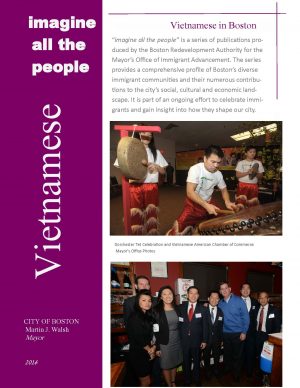Lunch time at Banh Mi Ba Le, a Vietnamese-owned shop in Fields Corner, 2015. Jesse Costa/WBUR.
Vietnamese refugees and immigrants have been coming to greater Boston since the end of the Vietnam War and are now the second largest Asian immigrant group in the region. In the wake of the Vietnam War, a thirty-year conflict that killed millions of people and left the country devastated, the US became one of several countries to resettle Southeast Asian refugees. The first to leave were several thousand South Vietnamese military and government officials who departed with US forces in 1975. As a refugee crisis unfolded over the next decade, the US took responsibility for resettlement of roughly a million people who feared persecution under Communist rule. The Boston area was one of the top ten resettlement sites in the country; by the year 2000 more than 30,000 Vietnamese were living in Massachusetts, roughly a third of them in the city of Boston.
While those who came after the war were mainly from the country’s Catholics elite, subsequent arrivals came from various class and religious backgrounds. They included many ethnic Chinese—mainly entrepreneurs who were often resented by the Vietnamese—and those from rural areas of Vietnam. Many of these so-called “boat people” of the 1980s fled the country in small leaky boats, facing perilous crossings, violence, and trauma. Most spent months or even years in refugee camps in neighboring countries. A final surge of refugees came to Boston in the early 1990s under special US legislation granting entry to former political prisoners and Amerasians (children of Vietnamese women and American GIs). Although the refugee migration trailed off in the early 1990s, Vietnamese continued to migrate to the Boston area under family reunification provisions.
Settlement
In the 1970s, federal refugee policies dispersed Southeast Asian arrivals across the country, placing them in areas where few immigrants lived. Feeling isolated, many relocated to larger cities or towns where they could find support among family and countrymen. In the 1980s, federal policy changed to permit clustering of refugees within certain neighborhoods. Vietnamese refugees thus resettled in Boston’s Chinatown (especially the ethnic Chinese) and Allston-Brighton, as well as parts of Dorchester and East Boston.
Soon the Fields Corner section of Dorchester emerged as the region’s largest and most important Vietnamese community, accounting for roughly a third of the city’s Vietnamese population by 1990. At the same time, surging housing costs and development pressures drove many Vietnamese out of Chinatown and Allston-Brighton. Many of those families moved to Fields Corner but also to the suburbs of Quincy, Randolph, and Malden, all of which developed substantial Vietnamese communities by the twenty-first century.
Work
While the earliest arrivals were mainly professionals, most of the Vietnamese who followed were less educated and initially found work in computer assembly and other manufacturing plants. Over time, they moved into lower paid service occupations such as restaurant work and transportation. Locally, the Vietnamese developed niches in occupations such as floor sanding and nail manicuring. The second generation has demonstrated a higher level of educational attainment and a greater number have moved into professional, sales, and other white-collar occupations.
Small business has been a main avenue of upward mobility for the Vietnamese. The proliferation of Vietnamese restaurants, bakeries, and nail salons has played an important economic role in the Asian enclaves of Fields Corner, Chinatown, and North Quincy. In the 1980s and 1990s, in fact, Vietnamese entrepreneurs who opened restaurants and businesses along Washington Street helped to revitalize the western edge of Chinatown while displacing the Combat Zone, a notorious adult entertainment district.



